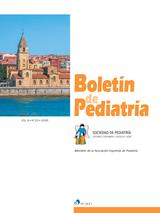Características de los neonatos trasladados al hospital de referencia regional en Asturias
A. Pérez Pérez , S. Martín Ramos , C. González López , A.I. Elola Pastor , D. Alonso Losada , C. Vicente Martínez , M.A. Ibáñez Fernández , G. Solís Sánchez
Bol. Pediatr. 2020; 60 (253): 116 - 121
Introducción. La regionalización de la asistencia neonatal es un punto importante de la asistencia pediátrica de calidad. Los traslados interhospitalarios neonatales forman parte de esta regionalización. Objetivo. Analizar las características de los neonatos trasladados al hospital de referencia en Asturias. Material y métodos. Estudio observacional retrospectivo y descriptivo de los pacientes neonatales trasladados al Servicio de Neonatología del hospital regional de referencia, entre enero de 2017 y diciembre de 2018 en Asturias. Resultados. Se incluyeron 136 pacientes (56 mujeres y 80 varones), lo que supone un traslado cada 5 días, el 1,8% de los neonatos nacidos en los hospitales emisores y el 14,4% de los ingresos en el hospital receptor. El 63,2% ingresaron en la unidad de cuidados intensivos y el 36,7% en la sala de cuidados intermedios, con un tiempo de ingreso medio de 9,5 días. El 20,7% eran prematuros. El peso medio al nacimiento fue de 2.983 g. La edad media al traslado fue de 5 días y el 46,3% de los traslados se realizaron durante las primeras 24 horas de vida. Las causas más frecuentes de traslado fueron: respiratorias (25%), neurológicas (14,7%), digestivas (13,2%) e infecciosas (12,5%). El 38% de los pacientes precisó soporte ventilatorio y el 1,4% falleció durante el ingreso. Conclusiones. Los traslados neonatales interhospitalarios son relativamente frecuentes en nuestra región, siendo el distrés respiratorio y los problemas neurológicos las causas más comunes. El análisis de la regionalización de la asistencia neonatal resulta especialmente importante en regiones con escasa natalidad debido a la crisis demográfica.
Characteristics of the newborns transferred to the regional reference hospital in Asturias
Introduction. Regionalization of neonatal care is an important point of quality in pediatric care. Neonatal interhospital transfers between regional hospitals and referral centers are part of this regionalization. Objective. To analyze characteristics of newborns transferred from the different regional and private hospitals to theregional reference hospital in Asturias during 2017 and 2018. Materials and methods. An observational, descriptive and retrospective study was conducted, including all neonatal patients transferred fron other Asturian hospital to Neonatology Service of HUCA between January 2017 and December 2018, in Asturias. Results. 136 patients were included (56 female and 80 male), which represents a transfer every 5 days, 1.8% of the 7,563 neonates born in the sending hospitals and 14.4% of the neonatal admissions in the receiving hospital. 63.2% of patients were admitted to the neonatal Intensive Care Unit and 36.7% to the neonatal Intermiediate care room with a mean admission time of 9.5 days. 20.7% were preterm newborns. The average born weight was 2,983 g. 20.6% were less than 2,500 g. Average age at transfer was 5 days, being the 46.3% made during first 24 hours of life. The most frequent causes of transfer were: respiratory (25%) neurological (14.7%), digestive (13.2%) and infectous (12.5%). 38% required ventilatory support and 1,4% died during admission. Conclusions. Neonatal inter-hospital transfers are relatively frequent in our region, with respiratory distress and neurological problems being the most common causes. The analysis of neonatal care regionalization is especially important in regions with low birth rates due to demographic crisis.
Artículo completo (PDF) (99 kb.)
- Neonatología
